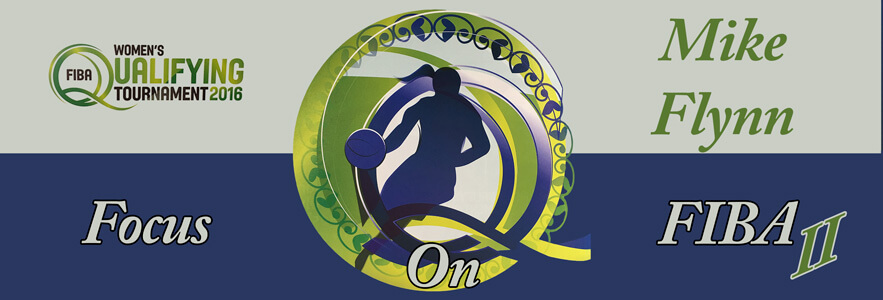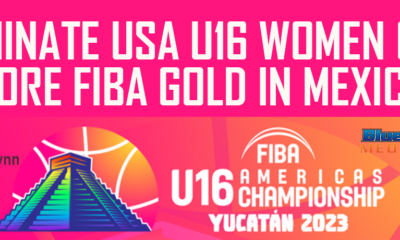
REZE, France — The beauty of watching this FIBA Olympic Qualifier is the ability to view games without the hard-core, constant evaluation mode necessary at any of the USA Basketball women’s youth trials. For those you have to watch every scrimmage and every drill across 2 or 3 courts while ranking moves, body language and skill sets. It’s important to view each player’s potential in three core areas: Elite Travel Basketball, High School Basketball to College jump and future Pro/International competitor. It’s this inability to do all three that has put the USA youth women in non-gold positions over the last two u18 3X3 and the u16s last summer.
Here in Reze they know how to do women’s basketball. Back in 2001 I watched Candace Parker (Tennessee/LASparks) make her international name at the age of 15 getting 35 points and 20 rebounds against the favored Russian National Team. She was offered a French professional contract right after the game while still just a high school sophomore.
The Reze Council built a new arena to go with their serviceable gym where the RBI has been held for over 20 years. The 4,328 seat La Trocardiere is first class and Spartan at the same time with great sight lines and simple seating. The history of the RBI and its support of women’s basketball was a natural fit for the FIBAOQT which happens to be running in France the same time as the much publicized Euro2016 Soccer matches. Unfortunately, until I got inside the gym it was hard to find any signage telling you the event was in town. Once inside, however, it was spectacular.
A secondary reason for hosting the event is to give the France team a home crowd as well as limited travel to help them get to Rio. In London (2012) the French woman won their first ever team medal by finishing runner-up to the USA and grabbing the silver. It was rumored that after the French beat Russia in the semis, they partied that night as being assured the Silver medal. With Serbia taking the FIBA Europe slot from them last year 76-68, getting to Rio is now the sole priority.
The last FIBA Women’s World Championships in 2014 saw the USA beat Spain in the final. Australia crushed host Turkey for third, Canada edged China for fifth while France beat Serbia for seventh. Since last year the two teams who have “grown” the most are Canada and Serbia.
The second day’s best game in Reze was Nigeria coming from behind with the only 3-point shot made by Ezinne Kalu with 4.3 seconds remaining to beat Korea 70-69. It was a huge win for Nigeria who has always had the talent but not the support of the Nigerian Basketball Federation. The physicality and intense rebounding that rivals the USA and France enabled Nigeria to push Korea around the basket.
While Nigeria has physical talent but not the organization, Korea is on the opposite track with plenty of intense play and skill sets but a lack of depth and height to compete at the Tier 1 level. The rest of the games were blowouts as Spain beat China 77-43, Turkey beat Argentina 66-38 and France crushed New Zealand 70-52. It was a day for the Tier 1 teams to beat up on those trying to move up.
The four teams who look to make it through the Quarterfinals will be: France (A1), Turkey (B1), Spain (D1), and a battle between all three teams in Group C: Nigeria, Belarus and Korea, all really Tier 2 teams. France-Argentina (B2), Turkey-Cuba (A2), Spain-Nigeria (C2) and Belarus (C1)-China (D2). The battle of the losers will be brutal since there are major countries with basketball histories in their areas. Cuba could knock off Turkey and China could upend Belarus. It’s easy to see where the waters divide between Tier 1 and Tier 2 teams.
And, if you’re inclined to see this prognostication play out, FIBA has created a massive Media and TV portal to view these games. If you viewed either the game or the event web site, you’ve seen the quality. The limited media here has enjoyed an amazing level of professional staffing and support from detailed rosters, pictures, supporting web sites and every kind of social media interaction with the both teams and the event itself. Women’s college basketball in the US does not have this high quality level of professional feel and look. Between the website statistics and live-stream coverage you can sit at home and take it all in. Just 10 years ago you couldn’t even find a roster or a correct name and number. The changes with FIBA Media are to be envied by US colleges and conferences.
With all this digital assistance from FIBA Media my goal is to cover the first two days of the event to personally and to view as many teams as possible evaluating not only the team rosters but their play and thepotential upward mobility of their national programs. With so many foreign players finding their way onto US college rosters it’s important to see if they can also successfully translate their skills to their own national teams.
As mentioned in last night’s article, at the end of the month in Zaragoza, Spain FIBA will hold the u17 World Championships. With so much young talent heading to Spain and the NCAA greenlighting college coach’s attendance it promises to be one of the more watched events in recent history. There’s been some amazingly detailed stories on the u17 teams by Paul Nilson (@basketmedia365) who’s got spot-on observations of the talent headed to Spain. Every coach wishing to view it on FIBA tv portal or in-person should review what they’re expecting to see.
NOTES: The USA women leads the world’s with a No. 1 ranking followed by Australia, Spain, France, Czech Republic, Russia, Brazil, China, Canada and Belarus/Turkey tied for 10th. The results are not as smooth on the u18 3X3 front as the USA finished the last two years with Silver and ranks just 8th out of 20 in team rankings. Worse off is the USA Men’s 3X3 u18s with a 19 out of 20 team ranking due to not having enough FIBA 3X3 events to qualify a team. Overall 3X3 participation in your Federation helps the rankings to get an invite. The USA Boys ranked No. 1 haven’t been able to qualify into the 3X3 system due to low event numbers.
FIBA will start their event new Men’s Event system for older teams (say Olympics-National Teams) that will serve as a qualifier to the 2019 FIBA Basketball World Cup next year. While no one is saying it, the desire is to have the 2019 World Cup replace the Olympics as the BIG event for National Teams to compete and win. Right now the Olympics is “owned” by the International Olympic Committee (IOC) and there is a desire by powers (let’s say NBA & FIBA) to get the big competition event under their basketball umbrella and push the Olympics to a u23 event. This means the NBA stars would be insurance covered (and maybe paid pool money) to compete while under the present rules they are covered, not paid and not supporting global basketball entities.
This has led to the struggle by FIBA to get the EuroLeague to give up their National team players for the FIBA EuroCup which they want to control as a lead up to the World Cup. This issue is still being discussed around basketball circles in Europe. The big money teams in the EuroLeague are pushing back. For the USA most of the top players are in the NBA and since it supports the World Cup idea there will be no issue as it will be hammered out in the next CBA.
The first FIBA World Cup for Men is to be played 2019 in China and will increase the participation with up to 32 participating teams (7 from the Americas). Qualification for the 2020 Tokyo Olympic Games will go through the 2019 FIBA Basketball World Cup and four Olympic Qualifying Tournaments with seven teams selected and four more chosen by the Central Board, plus host for 12 teams. Right now that’s the idea for the men but there is a desire to get younger (u23) players into that as a platform for them to win and grow their game.
The FIBA Women’s World Cup will continue on its four-year cycle and will not change like the men. The WWC will take place in September 2018 with Spain hosting the event.
AGES: The USA Women’s National Team might be the oldest team of all 2016 Olympic competitors at an average age of 29.6. If you take out Breanna Stewart (21) the average jumps to 30.45 years. At the FIBA Olympic Qualifier here in France the oldest team is Cuba at 29.3 years old. Cameroon, China and New Zealand are the youngest at 25. Heights also counts as it wears some teams down on the boards and cutting off drives. China is the tallest here averaging 6-1 followed by France (6-0), Turkey (6-0), Spain (6-0) and outlier Cameroon (6-0).
Mike Flynn is owner and operator of Blue Star Basketball and U.S. Junior Nationals. He is a National Evaluator and publishes the Blue Star Report which ranks the top 100 high school girls basketball players in the nation. He also serves as Secretary of the Middle Atlantic District AAU, National Chair for AAU Lacrosse, Consultant to Gatorade for girls basketball, member of the McDonald's All–American selection committee, & Consultant for Nike Global Basketball.









